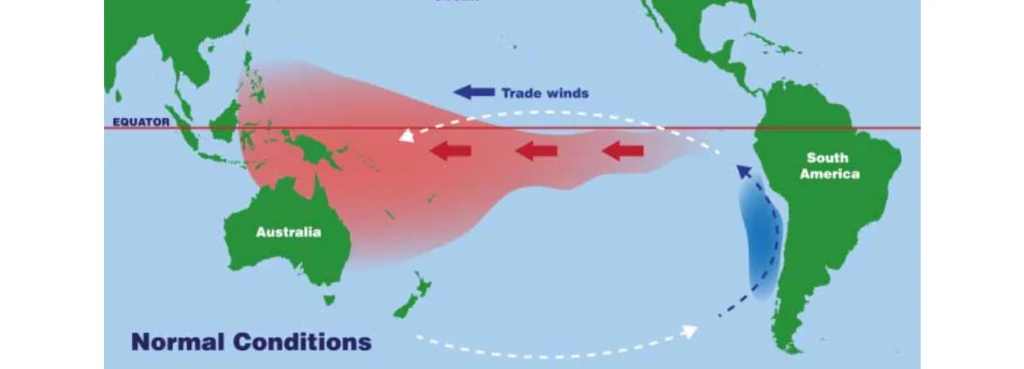Table of Contents
Introduction:
The El Niño–Southern Oscillation (ENSO) and Indian Ocean Dipole (IOD) are two well-known temporal oscillations in sea surface temperature (SST), which are both thought to influence the interannual variability of Indian summer monsoon rainfall (ISMR).

ENSO:
El Niño-Southern Oscillation (ENSO) is a climatic event with three possible phases. These phases, called “El Niño,” “La Niña,” and “Neutral,” involve significant modifications to both the oceanic and atmospheric conditions as ENSO is an interconnected climate event. Despite having three distinct phases, ENSO is a single phenomenon. El Niño and La Niña can impact weather, wildfires, ecosystems, and economies globally. These phenomena usually last for nine to 12 months, though some can persist for years. While they do not adhere to a regular schedule, El Niño events are generally more common than La Niña events.
To comprehend the progression of El Niño, one must grasp the Pacific Ocean’s non-El Niño state. Typically, powerful trade winds move westerly over the tropical Pacific region, between the Tropic of Cancer and the Tropic of Capricorn. These winds drive the warm surface water towards the western part of the Pacific, adjoining Asia and Australia. As a result, the sea’s surface level in Indonesia is usually approximately 0.5 meters or 1.5 feet higher, and the temperature is 7.2°C or 45°F warmer compared to Ecuador. This warmer water is driven towards the west, leading to cooler water rising from the depths and moving towards the coasts of Chile, Peru, and Ecuador. It is commonly referred to as “upwelling.” It creates low pressure in the western Pacific region and high pressure in the eastern Pacific region.
The low-pressure area formed by the warmer surface water near Indonesia causes the air to move upward, leading to cloud formation and intense precipitation. This process is critical in developing the monsoon system that brings rainfall to India. As altitude increases, there is a shift in air movement towards the eastern Pacific Ocean in a direction opposite to the trade winds that move at lower altitudes. This wind system creates a loop, moving from east to west near the surface and west to east at higher altitudes, reinforcing the temperature gradient between the eastern and western Pacific Ocean.
Upwelling is the process wherein cold, nutrient-dense water is delivered to the euphotic zone, also known as the ocean's uppermost layer. This cold water contains valuable nutrients such as phosphates and nitrates, which microorganisms like phytoplankton use to create energy through photosynthesis, a process powered by sunlight. This phytoplankton serves as a source of food for other marine organisms, including clams, which are, in turn, preyed upon by predators such as fish or marine mammals.

El Nino:
During El Nino, westward-blowing trade winds weakened; as a result, warm water accumulated in the western Pacific region began to flow eastwards toward the Peruvian and Chile coast due to gravity. It weakens the low pressure in the western Pacific region, thus weakening the whole air circulation cycle and disrupting global atmospheric circulation. Global atmospheric circulation is the large-scale movement of air that helps distribute thermal energy (heat) across the surface of the Earth.

Effects of El Nino:
- Due to low pressure near the Peruvian and Chile coasts, rainfall increases drastically, creating coastal flooding and destroying infrastructure.
- A thick layer of warm water across the eastern Pacific blocks the upwelling of nutrients rich cold water causing marine animals to migrate or die and thus destroying the coastal ecosystem.
- It weakens the monsoon winds and brings droughts to the Indian subcontinent and also to Australia and Indonesia.
- Unusual severe winter weather at the higher latitudes of North and South America are caused by the eastward movement of atmospheric and oceanic heat sources.
La Nina:
During La Nina, westward flowing trade winds grew more robust, thus reinforcing the normal air circulation cycle. Over Indonesia, rainfall increases while decreasing over the central tropical Pacific Ocean. It makes Monsoon winds stronger and brings heavy rainfall over the Indian subcontinent.
Indian Ocean Dipole (IOD):
The Indian Ocean Dipole (IOD) is defined by the difference in sea surface temperature between two areas (or poles, hence a dipole) – a western pole in the Arabian Sea (western Indian Ocean) and an eastern pole in the eastern Indian Ocean south of Indonesia. The IOD affects the climate of India and other countries that surround the Indian Ocean Basin and is a significant contributor to rainfall variability in this region.
During a positive IOD event, the western Indian Ocean experiences warmer sea surface temperature relative to the east and receives higher-than-normal rainfall, while the eastern Indian Ocean experiences drier-than-normal conditions. This can lead to increased rainfall over India and can offset the effects of El Niño, which usually brings drier-than-normal conditions to India.
During a negative IOD event, eastern Indian Ocean receives higher-than-normal rainfall.
In scientific terms, the IOD is a coupled ocean and atmosphere phenomenon similar to ENSO but in the equatorial Indian Ocean. It is thought that the IOD has a link with ENSO events through an extension of the Walker Circulation to the west and associated Indonesian throughflow (the flow of warm tropical ocean water from the Pacific into the Indian Ocean).
Conclusion:
India Meteorological Department is solely responsible for issuing operational long-range forecasts for India. The forecasts are prepared at the National Climate Center of IMD in Pune. Currently, empirical (statistical) methods are used to prepare operational long-range forecasts. A better forecasting model can help the government make better policies to combat El Nino and equip people.




